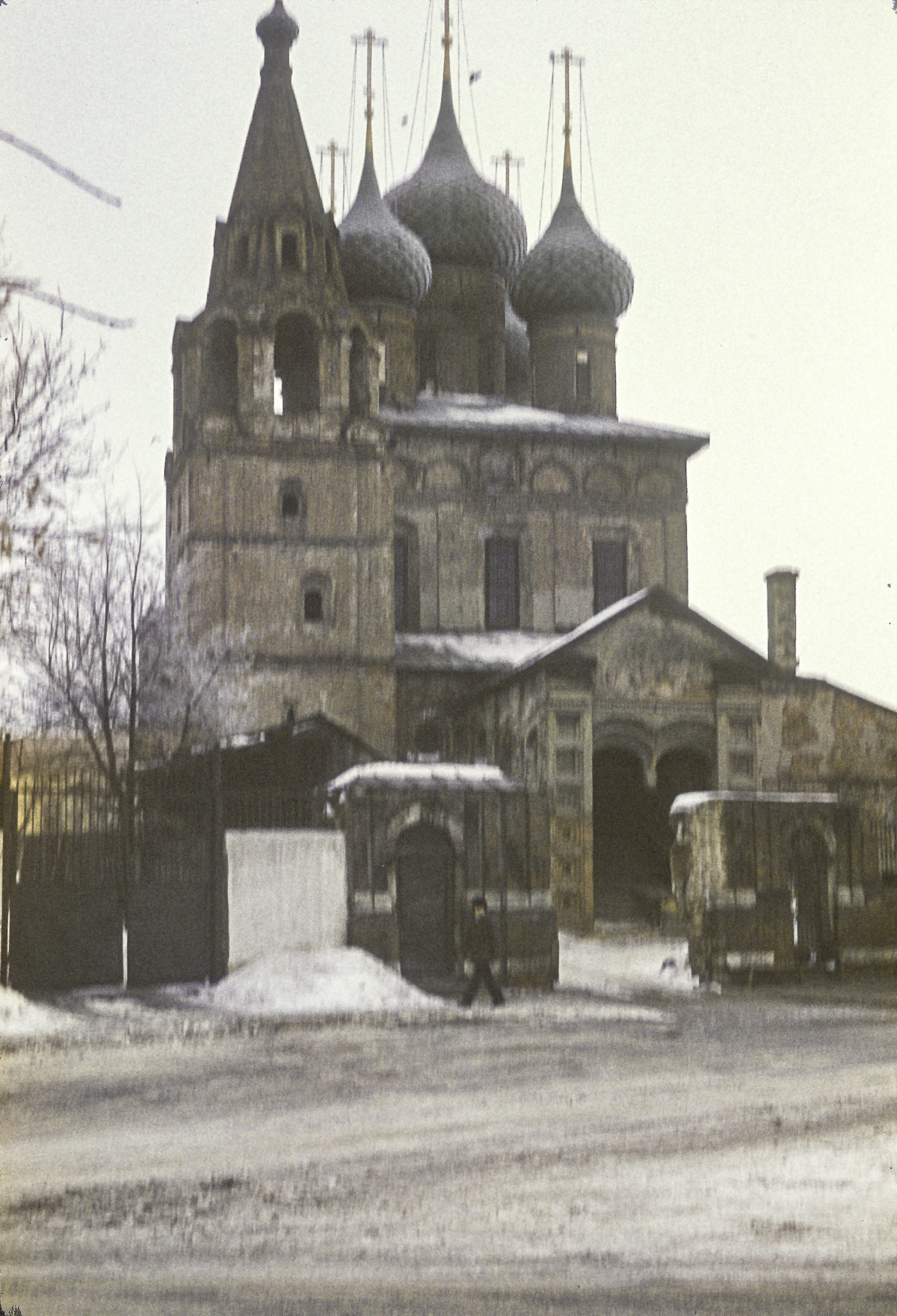Yaroslavl was the largest of the Golden Ring cities I visited, and the farthest from Moscow, at a distance of 250 kilometers or 160 miles. I found it to be the most modern and spiffy of the Golden Ring cities we visited, but also the one with the fewest monuments surviving from pre-17th century times. The reason for this is not because it is younger than the others; it was founded in 1010 by Yaroslav the Wise, then Prince of Rostov, who subsequently went on to rule as Grand Prince of Kiev from 1019 to 1054, and it is considered the oldest of the Russian towns on the Volga. But for its first two centuries, it was a minor outpost of the principality of Rostov-Suzdal; eventually, in 1218, it became the capital of its own principality, but two circumstances conspired to delay its growth. Unlike Rostov, Suzdal or Vladimir, it lacked the princely patronage which provided those cities with great stone cathedrals and monasteries. It remained a city of wood, subject to devastating fires, one of which nearly consumed the entire town in 1222. Added to this was its exposed location on the Volga, where it was easily accessible to invaders, in particular the Mongols of the Golden Horde. The Horde first struck Yaroslavl in 1257 and returned several times in the century following, each time burning the city, decimating the population and forcing the survivors to start over from scratch. In the 14th century the Black Plague arrived, bringing another wave of mass death. Hardly had all these terrors begun to abate when, in 1463, the principality of Yaroslavl was swallowed up by the Grand Duchy of Moscow.
Paradoxically, the loss of its independence proved to be a blessing in disguise for the city of Yaroslav. Under Muscovite rule Yaroslav initially enjoyed a prolonged period of peace and stability, and it was able to take advantage of its favorable location on the Volga River to become the major entrepot for the river trade between the Baltic and England (via Arkhangelsk) and Moscow which developed in the 16th century. The prosperity thus engendered enabled the local elite to entertain thoughts of building in stone rather than wood, and as early as 1501, in the aftermath of a great fire which destroyed some of the city’s most venerated wooden structures, they began to do so. The rulers of Moscow provided substantial support by sending skilled artisans to help with the construction and munificent endowments for the projects undertaken. Ivan the Terrible was especially generous to Yaroslavl, making frequent pilgrimages to the city and bestowing rich gifts on its churches and monasteries.
The Time of Troubles at the beginning of the 17th century brought famine and foreign invasion to Muscovy, and Yaroslavl was not exempted from the general woe. Poles and Lithuanians, supporting pretenders to the throne of Muscovy, occupied Moscow and besieged Yaroslavl in 1609, inflicting severe damage on the city. Yet this proved to be only a temporary setback; Yaroslavl played a leading role in repelling the invaders and restoring order in the country, and with the end of the Troubles in 1613 its economic and demographic growth resumed. By the end of the 17th century it had become the second-largest city in Russia, with 15,000 inhabitants, and the accompanying prosperity gave rise to a proliferation of new building projects, mostly financed by local merchants. This is why most of the surviving historical treasures of Muscovite-era Yaroslavl date from the 17th century, with a few from the 16th.
The eighteenth century brought new challenges. The establishment of St. Petersburg on the Baltic Sea in 1703 adversely affected Yaroslavl, because it diverted the Western European trade which had formerly flown down the Volga river network from Arkhangelsk to more westerly routes, bypassing Yaroslavl. However, the city was able to compensate for this by investing in industrial enterprises, especially textiles. It also became a provincial capital in the 1770s, as well as the seat of an archbishopric, further enhancing its importance.
The development of Yaroslavl as an industrial, administrative and cultural center, as well as the enhancement of its municipal infrastructure, continued throughout the nineteenth century, right down to the outbreak of World War I. In 1897 the city had a population of over 71,000. But war and revolution brought a severe decline in the city’s fortunes. In 1918 Yaroslavl became a center of resistance against the Bolshevik Revolution, and the Red Army retaliated by besieging and shelling the city, inflicting numerous casualties and severe damage; subsequently the population and economy shrank precipitously. Yet eventually Yaroslavl managed to bounce back from that catastrophe too, becoming a key Soviet industrial and transportation hub during the later 1920s and 30s. In World War II, escaping occupation by the Germans, Yaroslavl’ became indispensable to the defense effort as a locus of armaments production as well as a source of manpower for the army. It continued to grow and develop as an industrial center following the war, with the population reaching half a million in 1968.
For me, one of the chief attractions of Yaroslavl, which none of the other Old Russian towns I visited could boast, was its location on the banks of the Volga River. This was the only time I ever saw that mighty stream in person, and I have to say that it is truly impressive. January is the coldest month of the year in Russia, and the Volga was completely frozen over. Although it’s less than a mile wide at Yaroslavl, it seemed much wider; I could hardly pick out distinct objects on the other side.
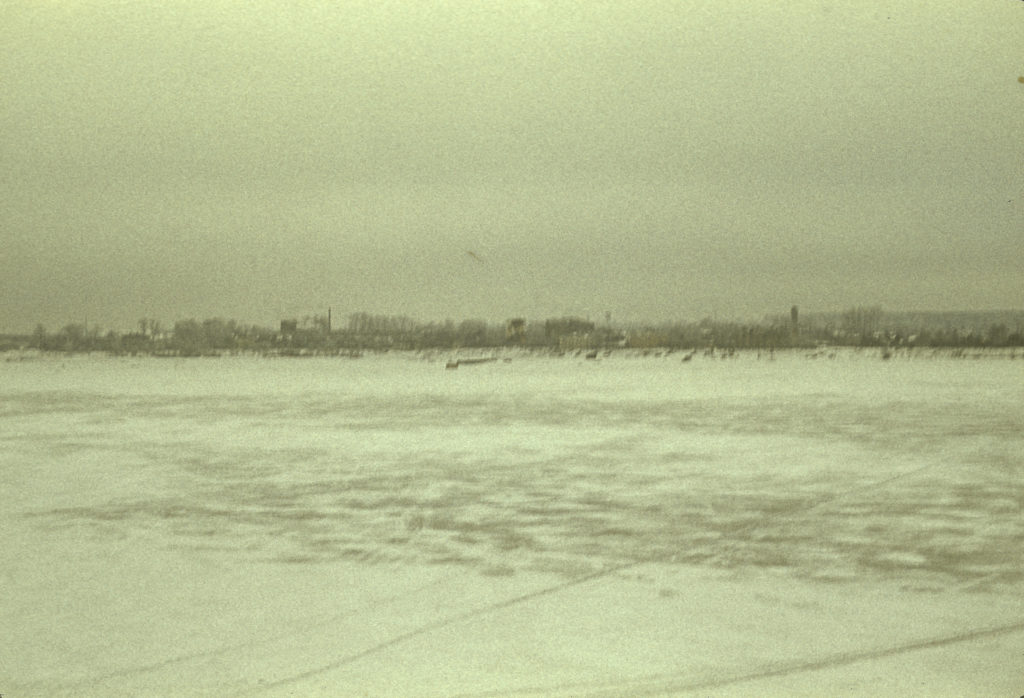
There is a park on the west bank of the Volga, known as the Volga Embankment Park in Russian, but I prefer to translate it as Bluff Park, a more succinct name (and one it shares with a much smaller park on the shore of the Pacific Ocean in my home town of Long Beach). Yaroslavl’s Bluff Park was created in the early 19th century, in the aftermath of a visit by Emperor Alexander I, who found the disorderly and bedraggled condition of the riverbank outrageous and ordered the locals to rectify matters immediately. They did, and ever since that time the riverbank has remained the pride and joy of the city, its chief promenade and an ideal venue for superb views of the river in all seasons.
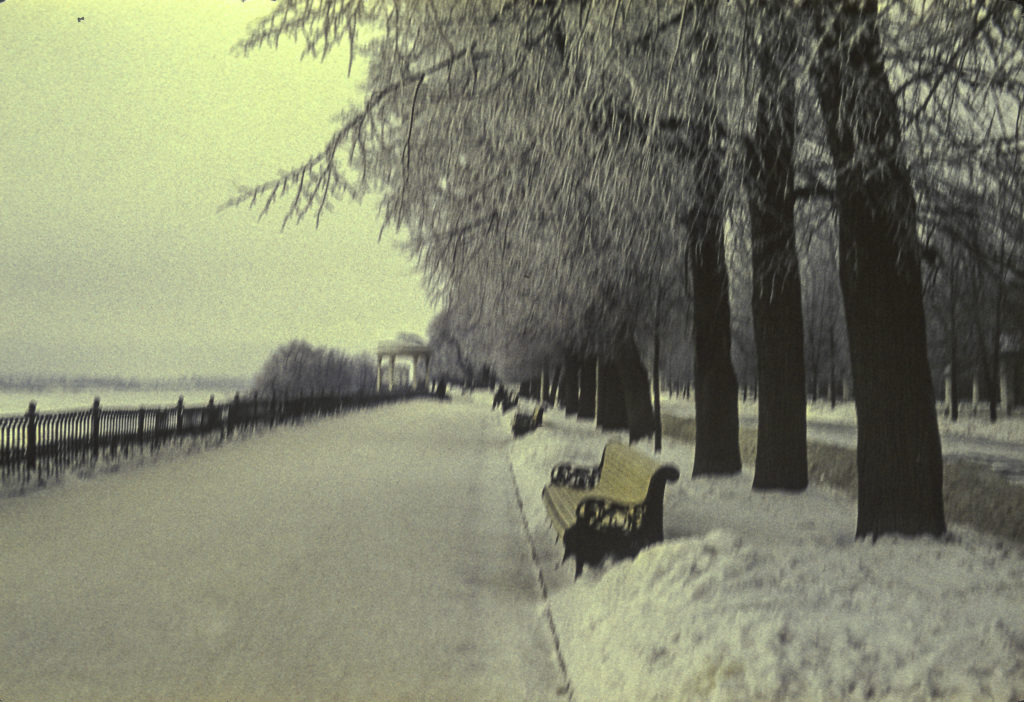
The Volga freezes over along almost its entire length during the months of December, January and February, and during that time river traffic mostly ceases. I would say “entirely” but for a small amount of pedestrian activity that I observed in the form of a lone figure fishing through a hole in the ice.
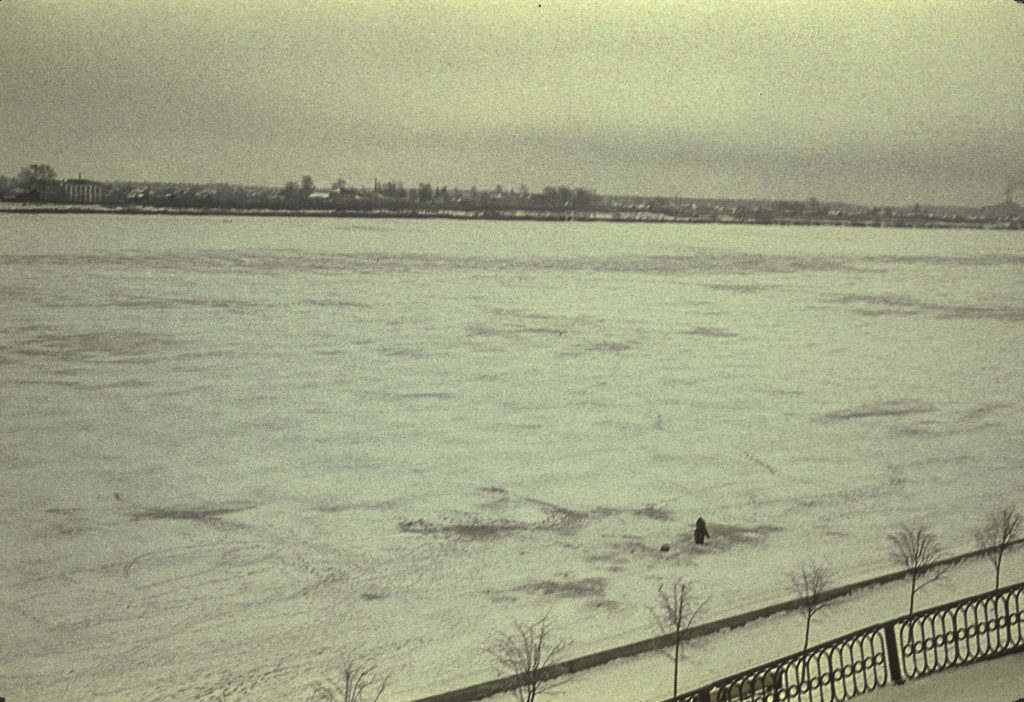
I could see snowmobile tracks too, but I didn’t see any snowmobiles while I was there; I doubt if there were many privately owned snowmobiles in Russia in 1972, although I suspect there are quite a few now. There were also a few idiots who ventured out to have their pictures taken on the ice, like the one in the picture below.

Yaroslavl was truly a winter wonderland. There had recently been an ice storm and all the trees and bushes were wreathed in frost.
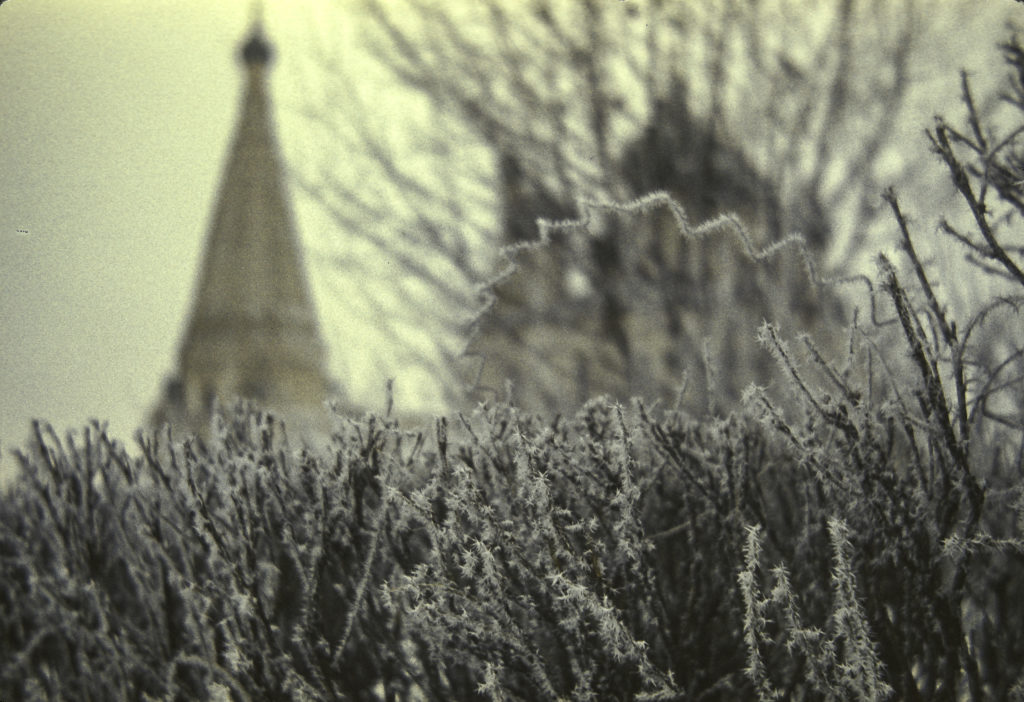
As we ventured inland from the river, we encountered what many consider to be the crown jewel of Yaroslavl, the Church of St. Elijah the Prophet, built in the middle of the 17th century with funds provided by a couple of local magnates, the Skripin brothers. The actual work was done by local craftsmen, and the interior was furnished with frescoes by famous artists of the time. In 1778 the city center was reconfigured on the basis of a radial street layout; the Church of St. Elijah was at the focus, in its own square, with the streets of the city radiating out from it, and a suite of government buildings situated nearby.
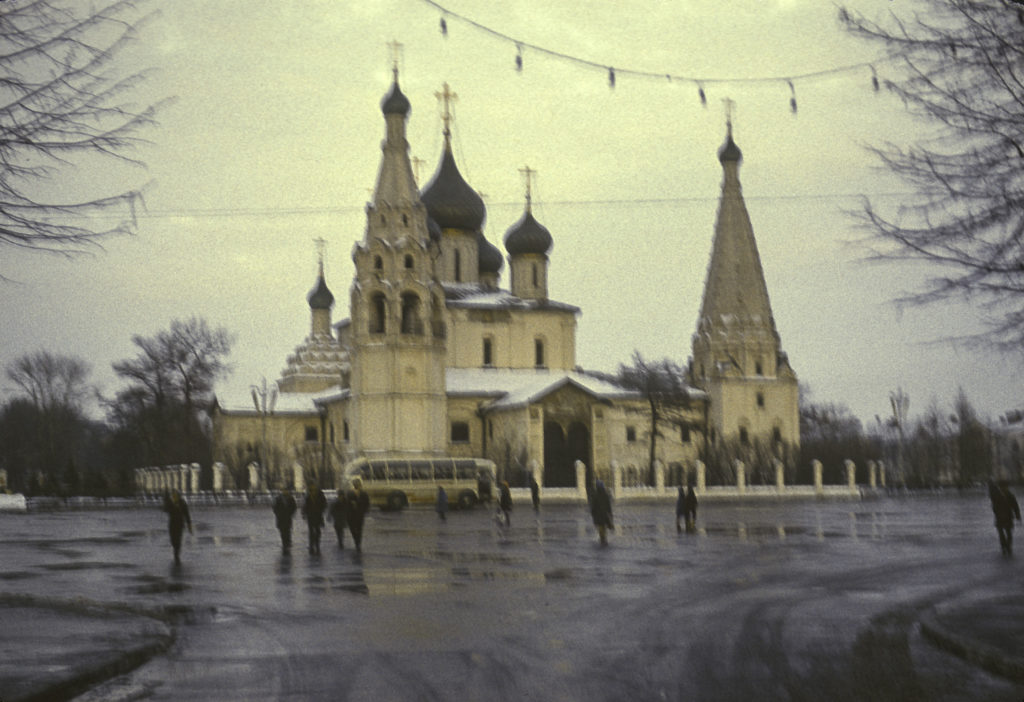
St. Elijah’s was refurbished and restored several times before the Revolution of 1917. In 1920 it was turned over to the Yaroslav Museum Reserve, and during the 1930s, when so many churches were being torn down to make way for Soviet construction, the museum workers succeeded in saving it from the wrecker’s ball. In 1938-41, however, it was turned into an antireligious museum, and a Foucault’s pendulum was hung under the dome (!). Nevertheless, after World War II, the Soviet regime occasionally permitted restoration work to be performed, and eventually, in 1989, allowed church services to resume in the summertime. But when I was there, in 1973, the interior was closed to visitors.
The government buildings behind St. Elijah’s enclosed a small park, the Governor’s Garden, which was apparently intended as a playground for children.
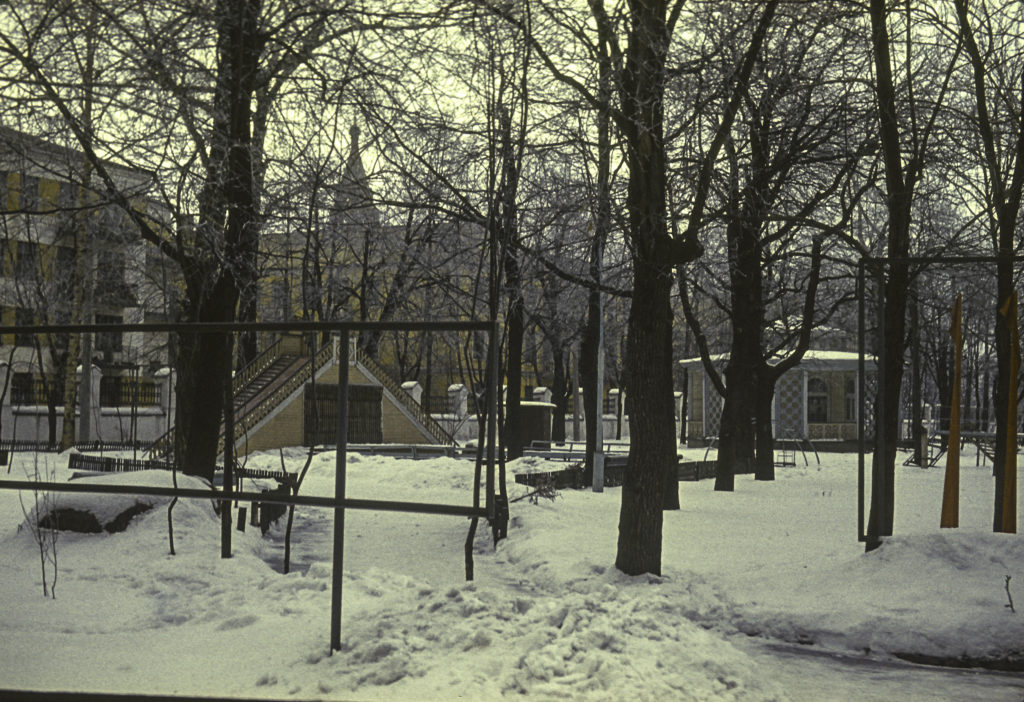
Not far away from St. Elijah’s stands the Church of the Nativity of Christ. This was built in 1644 on the site of an earlier wooden church, which according to legend served as a hiding-place for a miracle-working icon saved from the Polish invaders who besieged the city in 1609. Construction was funded by three brothers of the Nazarev family, a prosperous clan of the Yaroslav merchant community. It is one of the earliest stone churches to be built in Yaroslavl, and is said to be the first to have its walls adorned with tiles. Other than that it was constructed on a plan typical for Yaroslavl in that period, with a four-pillared core surrounded by galleries and crowned with a five-domed roof. Following the initial construction, numerous additions, modifications and enhancements were made, so that the current church barely resembles the original. In 1831-32, during the course of a renovation project sponsored by the local bishop, four of the domes were removed, and the central dome was reconfigured.
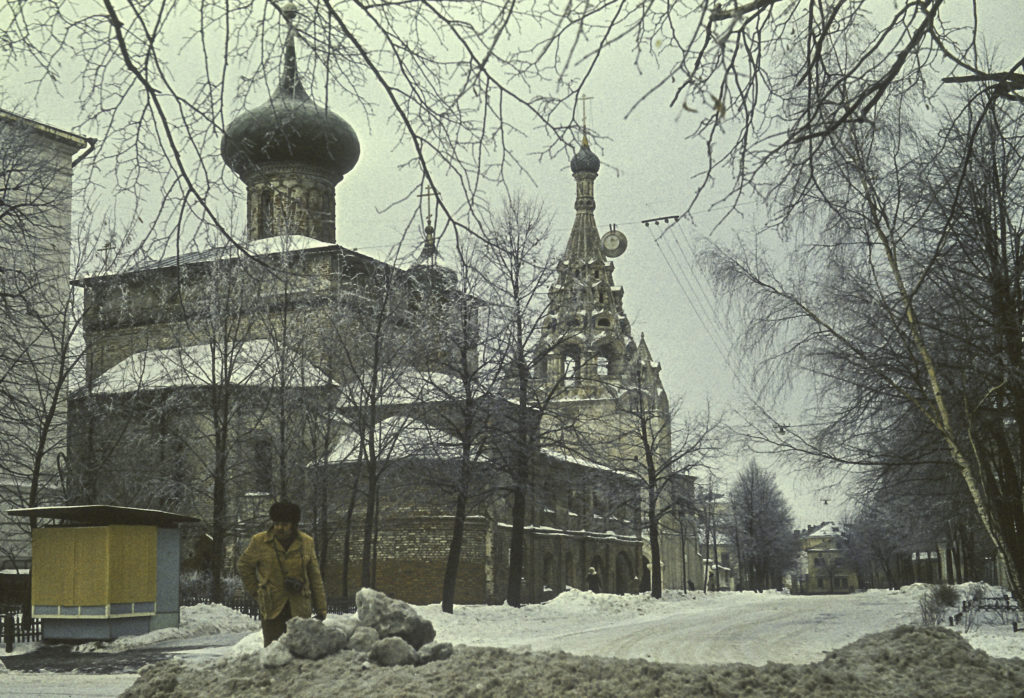
The Nativity Church was closed in 1922, and in 1929, after some restoration work, it was turned over to the Museum Department of the Main Administration of Scientific, Science-Artistic and Museum Institutions (Glavnauka), a division of the Ministry of Education, which rented it out as storage and living quarters. In the postwar era, restoration work was begun in 1959 and continued for the following decade; in 1970 it was turned over to the Yaroslavl Historical and Architectural Museum Reserve.
Proceeding a little farther from St. Elijah’s, past the government buildings on the square and toward the downtown shopping area, we encountered an imposing edifice on Deputies’ Lane, which turned out to be the Sretensky (Candlemas) Church. A note on Candlemas is in order here, because it is not widely celebrated anymore in the Western world, and not everyone, especially in the USA, knows what it means. Candlemas commemorates the ritual purification of Mary, 40 days after the birth of her son Jesus, as well as the ritual presentation of the baby Jesus to God in the Temple at Jerusalem. Where it is celebrated, it is customary to place lighted candles in the windows of one’s home.
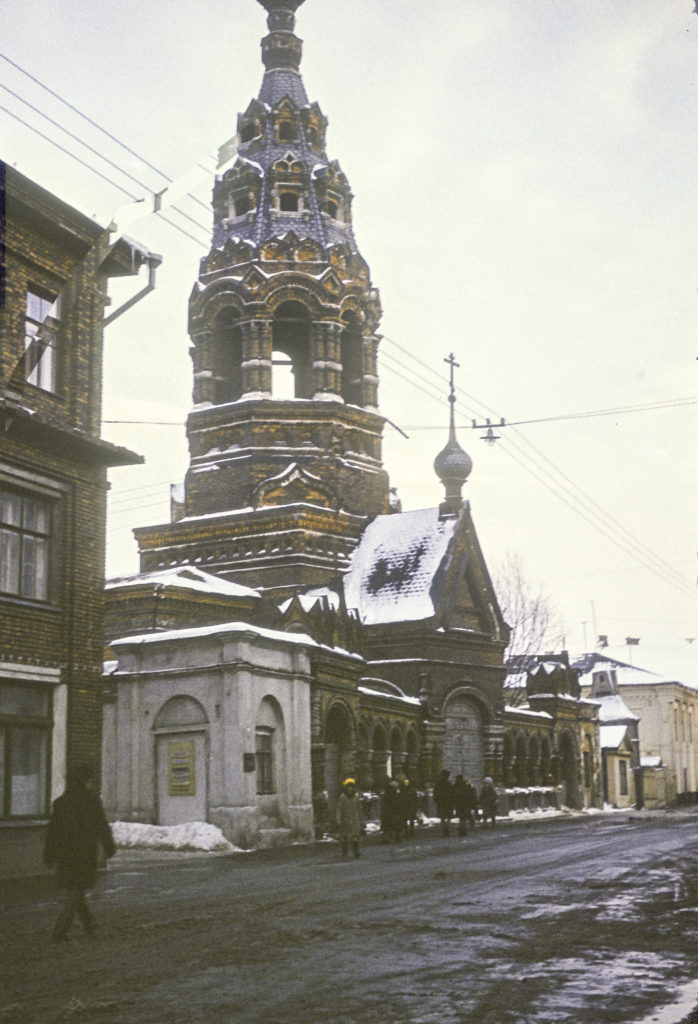
The original version of the Sretensky church was built in 1685. It was then only a simple two-story structure, and did not acquire the signature bell-tower until 1895, as part of a complete remodeling in pseudo-Russian revival style, financed by a wealthy Yaroslav industrialist, I. N. Dunaev, and conducted under the supervision of architect Nikolai Ivanovich Pozdeev. But it was to enjoy this enhanced status only until 1929, when it was appropriated by the Soviet regime and converted into a club for medical workers. Thereafter its maintenance was sorely neglected and it fell into decrepitude. In 1994 it was returned to the Russian Orthodox Church, but I have not been able yet to find out what has happened to it since.
Our leisurely meandering through downtown Yaroslavl eventually took us, as intended, to the Spaso-Preobrazhensky Monastery. Just outside it, we came across another striking attraction, the Church of the Archangel Michael. The original was built of wood in the early 13th century, but like so much else in Yaroslavl, the current masonry incarnation dates from the 17th century. Construction took place over a 25-year period between 1657 and 1682; during that period the architectural tastes of the local merchants who financed its construction changed, with the result that it incorporates elements from two stages in the development of Muscovite sacred architecture. The base of the church is very similar in form to the Church of St. Elijah (a four-pillar, three-apse structure completed in 1650), while the upper stories reflect the fashion of the 1670s and 1680s, which favored robust 5-domed roofs and large windows.
The Church of Archangel Michael has always had a close connection with the military, and for most of its existence has served as a garrison chapel. This was doubtless what the builders intended, given its location, which in the 17th century was known as the “Streltsy District” (streletskaya sloboda), the streltsy being the musketeers constituting the elite force of the Muscovite army in those days. The connection is also reflected in the church’s name: the Archangel Michael was considered the leader of the heavenly hosts in the wars against the hordes of Satan, and hence the patron of all Christian military forces. I have a poster from the Russian civil war period of 1918-21 which depicts Lenin and Trotsky, at the head of a mob of Bolsheviks, being driven over a cliff into hell by the Archangel Michael wielding a flaming sword. The association with the Archangel Michael was not calculated to endear the church to the Soviet regime, and in 1924 it was closed and began to fall into disrepair. Valuable artworks and sacral items were pilfered, and in general the interior suffered extensive damage. Judging from the pictures I took in January 1973, the exterior fared somewhat better, though not without some deterioration.
In 1994 the Archangel Michael church was returned to the Russian Orthodox Church, and by 2000 the exterior had been replastered and the stained-glass windows restored. But much else remained to be done, and I don’t yet have any information on the progress of the restoration in the last two decades.
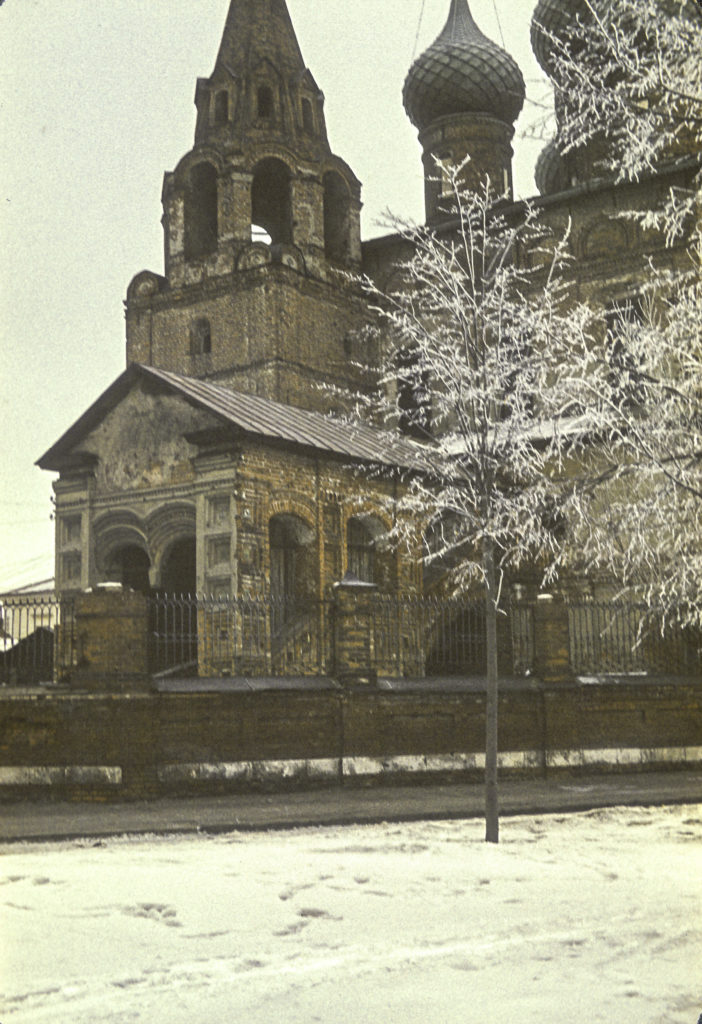
From the Archangel Michael church, we only had to cross the street to reach the final destination of our walking tour of Yaroslavl, the Spaso-Preobrazhensky Monastery. Actually, the monastery is only one component of a complex called the Yaroslavl Museum Reserve (Yaroslavsky Muzei-Zapovednik). Established by the Soviet government in 1924, this institution embraces a number of churches, museums, exhibitions and other attractions. Its collections contain over 350,000 items, which include icons, manuscripts, household goods, church implements, etc. Among the exhibits is one devoted entirely to the Lay of the Host of Igor, the great epic of medieval Russia, the sole surviving manuscript of which was discovered in the library of the Spaso-Preobrazhensky Monastery in 1795.
However, we had only a limited time to explore the complex before we had to catch the last train back to Moscow, so we decided to focus on the monastery, with its spectacular cathedral and bell tower.
The Spaso-Preobrazhensky Cathedral is the oldest surviving detached structure in Yaroslavl, having been built in the early 16th century, in the reign of Grand Prince Vasily III, who sent artisans from Moscow to assist with the construction. As was frequently the case in Yaroslavl, it replaced an older wooden version which had burned down in a fire in 1501. At the time I visited, the Spaso-Preobrazhensky Cathedral was undergoing restoration, as is evident in the preceding photo.
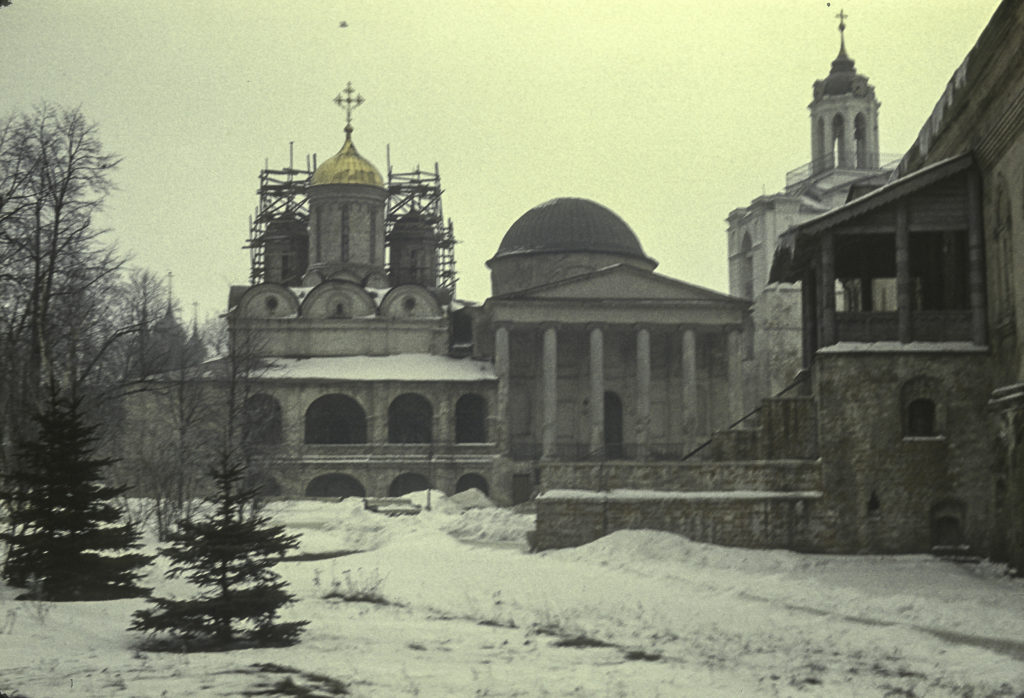
Next to the Spaso-Preobrazhensky Cathedral, rather awkwardly placed to my way of thinking, is a very different structure, the Church of the Yaroslavl Miracle Workers (Tserkov’ Yaroslavskikh Chudotvortsev). It too replaced an older building, the Church of the Entry of Our Lord into Jerusalem, damaged in the fire of 1501, but only after an interval of several hundred years. In the meantime, the Church of the Entry of Our Lord into Jerusalem was rebuilt (1619) and continued to stand until 1827, when work on the present church was begun. The new name, Church of the Yaroslavl Miracle Workers, commemorated the discovery of relics of a miracle-working prince and his sons in the basement of the original church in 1463. The new church, completed in 1831, embodies a mishmash of architectural styles. Classicism is manifest in the western facade (shown in the photo above), with a triangular pediment supported by Ionic columns. But the eastern facade harks back to the old Russian architectural tradition, with three semicircular apses constituting the altar area, and a cupola with a small dome sits on top. It looks rather incongruous, sandwiched in between the 16th-century cathedral and the 17th-century bell tower.
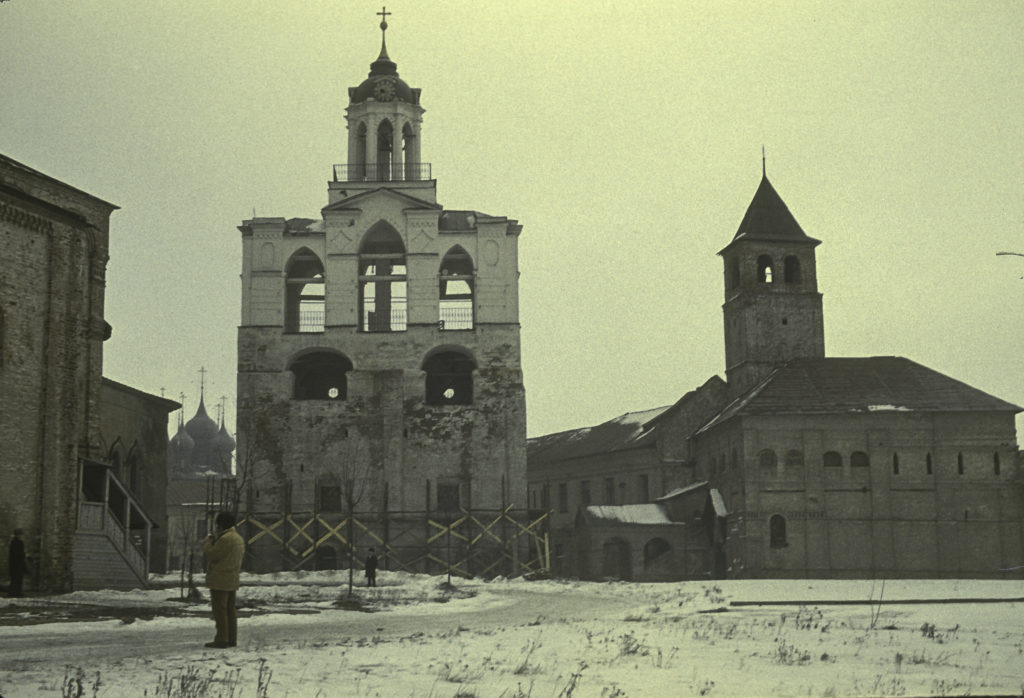
The bell tower was actually begun in the 16th century. The original tower consisted of two stories, with a chapel on the ground floor and the belfry on the second level. But over the following three centuries major modifications were made. In 1809 a third story was added which then became the belfry. The tower attained its final form in 1824 with the erection of the round 8-column gazebo on top.
The tower was badly damaged during the uprising of 1918, and although repair work was conducted in the 1920s and 1950s, it was not fully restored at the time I visited in 1973. In particular, the bells were still missing. They were finally remounted in 1991; among them were some original 16th-century bells.
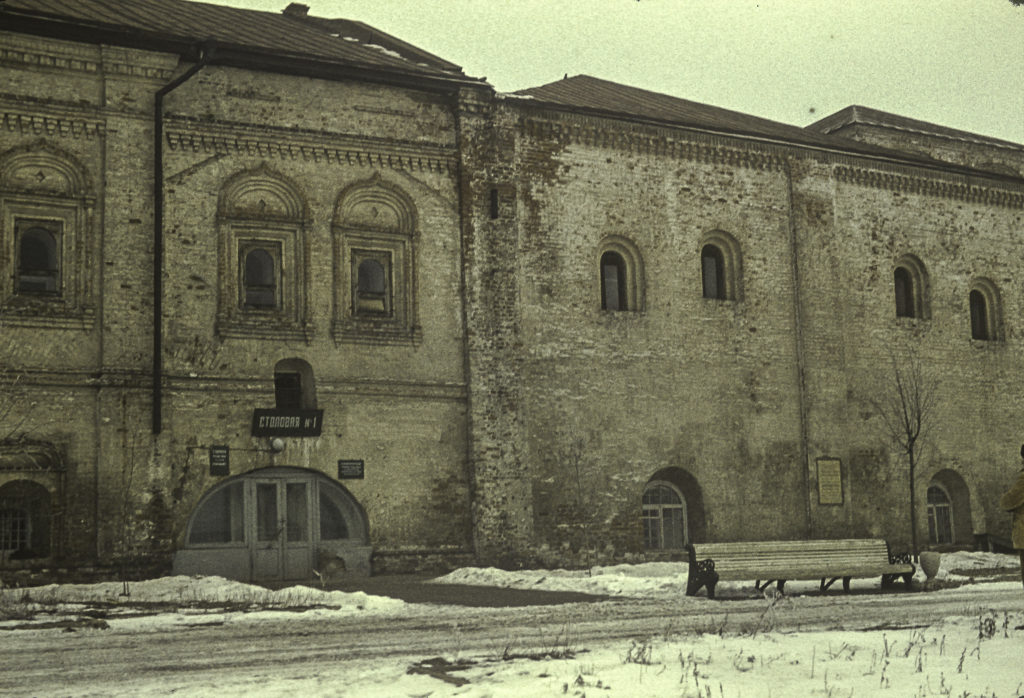
The Spaso-Preobrazhensky Monastery has been in existence since the 12th century, and in 1216-1218 it held the first theological seminary in northeast Russia, though this was shortly moved to Rostov, and the original versions of the Spaso-Preobrazhensky Cathedral and the Entry into Jerusalem Church date from this period also.
As I have already noted, there was a great fire in 1501 which destroyed or badly damaged much of the existing monastery, but it was followed by a great building spree which produced not only the present-day incarnation of the Spaso-Preobrazhensky Cathedral and the original version of the bell tower, but also the first stone walls and towers of the monastery. Later in the century, the monastery became one of the favorite beneficiaries of Ivan the Terrible, who showered favors on it in the form of land grants, fishing grounds, salt mines, tax exemptions and legal immunities.
Old Russian monasteries were typically intended not just as places of worship but also as citadels – kremlins in their own right – providing defense against foreign and domestic enemies. This was especially true of the Spaso-Preobrazhensky Monastery, whose 16th-century stone walls, replacing an earlier wooden stockade, stood the monastery in good stead during the Time of Troubles in the early 17th century. In 1609 Polish-Lithuanian forces, which had already occupied Moscow, attacked and destroyed most of the city of Yaroslavl, but the monastery held out against them. Later, in 1612, the monastery became the waystation where the forces raised in Nizhnyi Novgorod by Kuzma Minin and Dmitri Pozharsky stopped on their way to liberate Moscow from the invaders. Mikhail Romanov, the future tsar, issued his letter of acceptance to the throne while staying in the Spaso-Preobrazhensky Monastery on his way to Moscow in 1613.
In the aftermath of the Time of Troubles, the monastery walls were further strengthened and new towers were added. A spate of new construction occurred in the late 17th century, when a new dormitory wing for the monks was built. In 1747 a Slavic-Latin Theological Academy, one of the first in Russia, was opened on the grounds of the monastery.
In 1787, in connection with the transfer of the archbishopric of Rostov to Yaroslavl, the monastery became the archbishop’s residence. In the following decades major new construction was undertaken – the Church of the Yaroslav Miracle-Workers, Smolensk Chapel, a seminary wing and a sacristy – the last two of which appear in the preceding and following photos.
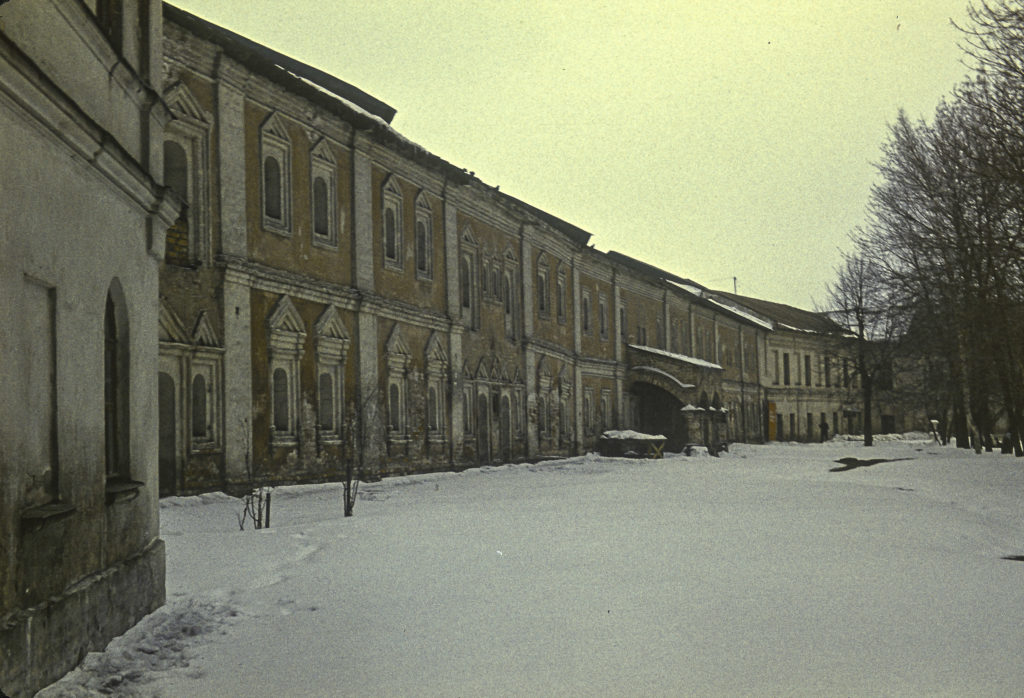
In the Soviet period, the monastery became the kernel of the Yaroslavl State Historical, Architectural and Art Museum Reserve.
